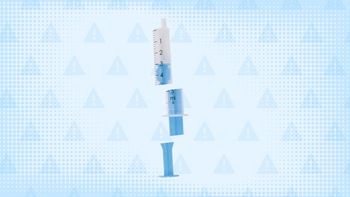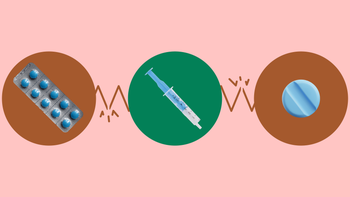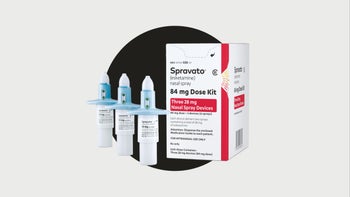
Spravato
Spravato (esketamine) is an NMDA antagonist that's used in adults for treatment-resistant depression (TRD) or major depressive disorder with suicidal ideation or behavior. Spravato (esketamine) is a nasal spray that you must go to a provider's treatment center to take. Side effects include sleepiness and dissociation (feelings of detachment from the environment). Because of the medication's serious side effects and risks, you must enroll in a program called the Spravato Risk Evaluation and Mitigation Strategy (REMS) to receive treatment.

What is Spravato (esketamine)?
What is Spravato (esketamine) used for?
Treatment-resistant depression (TRD) in adults
Major depressive disorder in adults with suicidal ideation or behavior (MDSI)
How Spravato (esketamine) works
Spravato (esketamine) is an N-methyl-D-aspartate (NMDA) receptor antagonist. It's not exactly known how the medication works to help with depression. But it's thought to balance the chemicals and signaling pathways in your brain that are involved with regulating your mood.
Drug Facts
More on Spravato (esketamine) essentials

What are the risks and warnings for Spravato (esketamine)?
Spravato (esketamine) can cause some serious health issues. This risk may be even higher for certain groups. If this worries you, talk to your doctor or pharmacist about other options.

Sleepiness, slowed breathing, and dissociation
Risk factors: Drinking alcohol while taking Spravato (esketamine) | Taking other medications that cause sleepiness or slow your body down
Spravato (esketamine) can make you very sleepy, which can affect your ability to focus, think, or react. The medication can also slow your breathing down, which can be dangerous. These side effects are more likely to happen or be more intense if you drink alcohol or take other medications that cause sleepiness or slow your body down. Additionally, Spravato (esketamine) can cause dissociation (when you're unaware of your surroundings or time).
To monitor for these risks, your provider will keep an eye on you at the treatment center for at least 2 hours after each dose of Spravato (esketamine) to make sure it's safe for you to leave. Make arrangements for transportation because you won't be able to drive or do anything requiring concentration until the following day after a good night's rest.

Potential for misuse and dependence
Risk factors: History of substance or alcohol use disorder | History of dependence
Spravato (esketamine) is a controlled substance because it has a risk of misuse and dependence. Misusing this medication raises your risk for serious side effects, which can be life-threatening. During treatment, your provider will monitor you closely to make sure you're using the medication appropriately.

Required to enroll in the Spravato REMS program
Spravato (esketamine) can put you at risk for sleepiness, dissociation, dangerously slowed breathing, and misuse. Because of these risks, this medication is only available through a restricted Risk Evaluation and Mitigation Strategy (REMS) program called the Spravato REMS program. All providers who prescribe Spravato (esketamine), pharmacies that dispense the medication, and people who take it must enroll in the program. This is to make sure the medication is distributed and taken under the safest conditions possible for you.

Suicidal thoughts and behaviors in young adults
Risk factors: Age 24 years and younger
Antidepressants like Spravato (esketamine) have been shown to raise the risk of suicidal thoughts and behavior in people age 24 years and younger. The risk is highest during the first few months of taking the medication and when your dose changes.
Get medical help right away if you or a loved one notices that you have worsening signs of depression, suicidal thoughts, or unusual behavior (e.g., anxiety, panic attacks, trouble sleeping, feeling angry or irritated) while you're taking Spravato (esketamine). This medication shouldn't be used for children under 18 years of age.

Higher blood pressure
Risk factors: Taking other medications that raise blood pressure
Spravato (esketamine) can raise your blood pressure. This typically happens about 40 minutes after your dose and lasts about 4 hours. Your risk of this happening is greater if you're also taking other medications that raise your blood pressure, such as stimulants or monoamine oxidase inhibitors (MAOIs).
Your provider will check your blood pressure before and after each of your Spravato (esketamine) doses. If needed, your provider might help manage your blood pressure while you're at the treatment center. Get medical help right away if you have any signs or symptoms of extremely high blood pressure, such as chest pain, shortness of breath, severe headache, and visual changes.

Problems with your mental abilities (e.g., thinking, concentrating, remembering)
Spravato (esketamine) is closely related to ketamine (Ketalar). Both Spravato (esketamine) and ketamine (Ketalar) can cause problems with your mental abilities, such as trouble remembering, learning new things, concentrating, and making decisions that affect your everyday life. Speak to your provider if this happens to you during treatment with Spravato (esketamine).

Bladder problems
Risk factors: Taking Spravato (esketamine) for a long time | Misusing Spravato (esketamine)
Some people who took Spravato (esketamine) reported having certain bladder problems, such as frequent urination, sudden urge to urinate, needing to urinate at night often, pain while urinating, and inflammation of the bladder. Contact your provider if you develop bladder problems in the middle of your Spravato (esketamine) treatment.

Harm to unborn baby
Risk factors: Pregnancy
Based on animal studies, Spravato (esketamine) might cause harm to an unborn baby if it's taken during pregnancy. Speak to your provider about the risks and benefits of this medication if you're pregnant or thinking of becoming pregnant.

What are the side effects of Spravato (esketamine)?
Common Side Effects
- Dissociation (feelings of detachment from the environment, 41%)
- Dizziness (29%)
- Nausea (28%)
- Sleepiness (23%)
- Vertigo (feeling like you or the room is spinning, 23%)
- Headache (20%)
- Changes in taste (19%)
- Numbness (18%)
- Anxiety (13%)
- Feeling sluggish (11%)
- Higher blood pressure (10%)
Other Side Effects
- Vomiting
- Diarrhea
- Constipation
- Dry mouth
- Nose and throat irritation
- Feeling drunk
- Feeling abnormal
- Euphoria (feeling of great happiness and excitement)
- Trouble sleeping
Serious Side Effects
- Extreme sleepiness
- Dangerously slow breathing: trouble breathing; bluish-colored lips, fingers, or toes
- Suicidal thoughts and behaviors: anxiety, panic attacks, difficulty sleeping, feeling angry or irritated, restlessness
- Extremely high blood pressure: chest pain, shortness of breath, severe headache, visual changes
Source: DailyMed
More on Spravato (esketamine) side effects
The following side effects have also been reported
Side effects that you should report to your care team as soon as possible:
- Allergic reactions—skin rash, itching, hives, swelling of the face, lips, tongue, or throat
- CNS depression—slow or shallow breathing, shortness of breath, feeling faint, dizziness, confusion, trouble staying awake
- Feeling disconnected from your thoughts, feelings, and surroundings
- Increase in blood pressure
- Thoughts of suicide or self-harm, worsening mood, feelings of depression
Side effects that usually do not require medical attention (report these to your care team if they continue or are bothersome):

Pros and cons of Spravato (esketamine)

Pros
Works well for treatment-resistant depression (TRD) and major depressive disorder with suidical ideation (MDSI)
Generally only need to take 1 or 2 times per week
Available through a program that helps makes sure the medication is as safe for you as possible

Cons
Can't give the medication to yourself at home (must go to a treatment center to take)
Requires 4 to 6 sprays per dose
Not recommended during pregnancy or while breastfeeding

Pharmacist tips for Spravato (esketamine)

Mark your calendar with your appointments to go to your treatment center to take your Spravato (esketamine) doses. This helps make sure you can be properly monitored and that you don't miss any doses.
It's recommended that you don't eat anything for at least 2 hours before your dose or drink anything for at least 30 minutes before your dose. This is because you might feel nauseous or vomit after you take Spravato (esketamine).
After you take your Spravato (esketamine) dose at your provider's treatment center, you'll need to stay there for at least 2 hours. Your provider must check for side effects (e.g., sleepiness, dissociation, blood pressure changes) before you can go home.
Since Spravato (esketamine) can make you sleepy and cause dissociation, make sure to arrange plans for transportation after your dose. You won't be able to drive yourself home. You can drive again the following morning after you've had a good night's rest.
If you need to use other nasal sprays on the same day you're taking Spravato (esketamine), make sure to use your other nasal sprays at least 1 hour before your Spravato (esketamine) dose. Otherwise, these other nasal sprays might lower how much Spravato (esketamine) gets absorbed through the nose and into your body.
Tell your provider about all the medications you're taking or planning to take. Taking Spravato (esketamine) with medications that cause sleepiness, slow your body down, or raise your blood pressure can put you at greater risk for side effects. Don't start taking any new medications without talking to your provider or pharmacist first.
If you miss an appointment for your Spravato (esketamine) dose, call your provider's office to see what you should do. Most times, you can continue with your current schedule as long as your depression doesn't get worse. But if you have worsening depression after missing your dose, let your provider know right away because your dose and treatment schedule might need to be changed.
Spravato (esketamine) isn't recommended for use during pregnancy or while breastfeeding since it might harm your baby. Talk to your provider if you're pregnant or thinking of getting pregnant to see what other options there are for you.
More on Spravato (esketamine) tips

Frequently asked questions about Spravato (esketamine)

How to save using GoodRx




Spravato (esketamine) dosage forms
Typical dosing for Spravato (esketamine)
This medication is given as a spray into the nose at a provider's treatment center. Each device contains 1 spray for each nostril and a total of 28 mg of esketamine.
Spravato (esketamine) is typically used along with an antidepressant that's taken by mouth.
Treatment-resistant depression (TRD):
Weeks 1 to 4: The typical starting dose is 56 mg sprayed into the nose on day 1. After the first day, the dose is 56 mg or 84 mg twice per week.
Weeks 5 to 8: The typical dose is 56 mg or 84 mg sprayed into the nose once per week.
Week 9 and beyond: The typical dose is 56 mg or 84 mg sprayed into the nose once every week or every other week, depending on how you respond to the medication.
Major depressive disorder with suicidal ideation or behavior (MDSI): The recommended dose is 84 mg sprayed into the nose twice per week for 4 weeks (1 month). The dose can be lowered to 56 mg twice per week if you're having side effects. After 1 month of treatment, your provider will decide whether you should continue treatment with Spravato (esketamine) based on how well you're responding to the medication.
More on Spravato (esketamine) dosage forms

Spravato (esketamine) contraindications

What are alternatives to Spravato (esketamine)?
Treatment-resistant depression (TRD) in adults
Major depressive disorder in adults with suicidal ideation or behavior (MDSI)
Generalized anxiety disorder - extended-release capsules only
Social anxiety disorder - extended-release capsules and tablets only
Panic disorder - extended-release capsules only

What is the latest news about Spravato (esketamine)?
Get savings updates for Spravato (esketamine)
Receive price alerts, news, and other messages from GoodRx about Spravato (esketamine) and other healthcare topics and relevant savings offers.By signing up, I agree to GoodRx's Terms and Privacy Policy, and to receive marketing messages from GoodRx.
References
Best studies we foundAl-Harbi, K. S. (2012). Treatment-resistant depression: therapeutic trends, challenges, and future directions. Patient Preference and Adherence.
Bahr, R., et al. (2019). Intranasal esketamine (SpravatoTM) for use in treatment-resistant depression in conjunction with an oral antidepressant. Pharmacy and Therapeutics.
Daly, E. J., et al. (2021). The effect of esketamine in patients with treatment-resistant depression with and without comorbid anxiety symptoms or disorder. Depression and Anxiety.
Janssen Pharmaceuticals. (2020). What is the Spravato® REMS (risk evaluation and mitigation strategy)?
Janssen Pharmaceuticals Inc. (n.d.). Instructions for use: Spravato® (SPRAH VAH’ TOE) (esketamine) - nasal spray device.
Janssen Pharmaceuticals Inc. (2023). Spravato- esketamine hydrochloride solution [oackage insert]. DailyMed.
Janssen Pharmaceuticals Inc. (2024). TRD efficacy and safety.
MGH Center for Women’s Mental Health. (n.d.). National Pregnancy Registry for Antidepressants.
Orsolini, L., et al. (2022). Craving and addictive potential of esketamine as side effects? Expert Opinion on Drug Safety.
Pereira, S., et al. (2021). Managing dissociative symptoms following the use of esketamine nasal spray: A case report. International Clinical Psychopharmacology.
Salahudeen, M. S., et al. (2020). Esketamine: New hope for the treatment of treatment-resistant depression? A narrative review. Therapeutic Advances in Drug Safety.
Browse medications
View AllResearch prescriptions and over-the-counter medications from A to Z, compare drug prices, and start saving.















